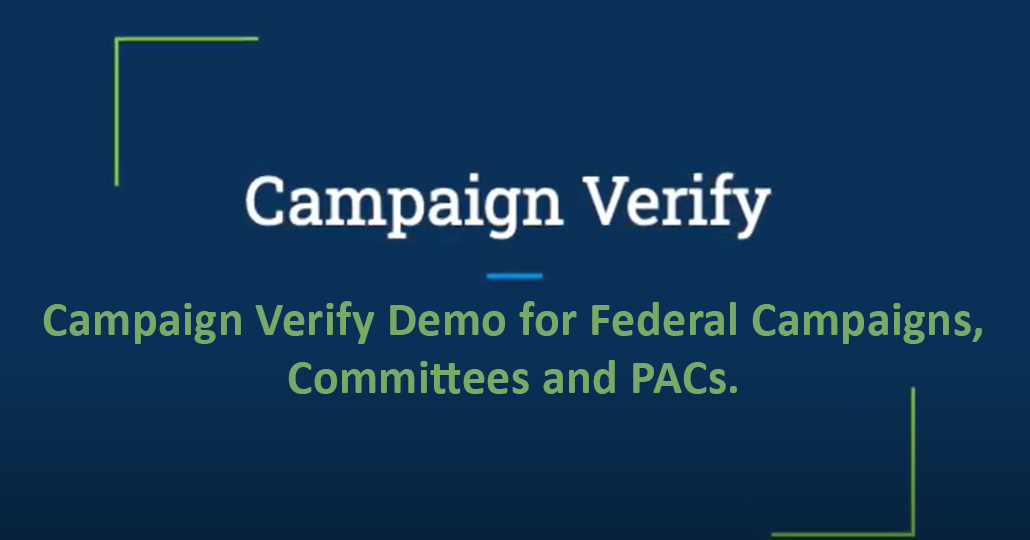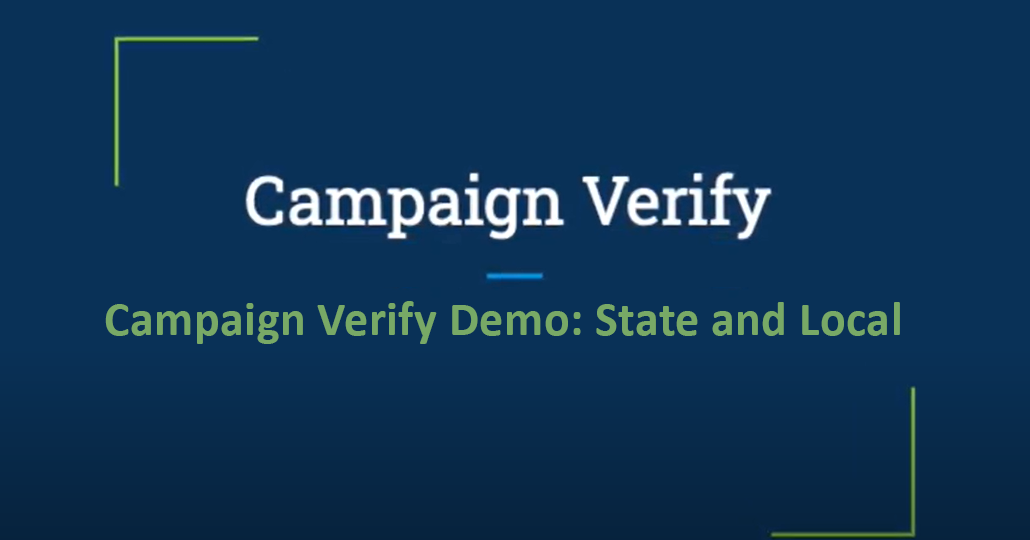

Campaign Verify has been approved by the Campaign Registry to ensure U.S. political entities are not improperly spoofed when they use local number 10DLC Texting services to communicate with voters.
U.S. political entities who file with a Federal, State, Local, or Tribal election authority are required to verify their identity using Campaign Verify.
5 steps to get verified!
1. Find your filing record online
2. Submit your information to Campaign Verify
3. Get your secret PIN code
4. Generate a token
5. Paste your token in Peerly & start texting
Campaign Verify Fees
527s Political organizations
Campaign Verify Vetting: $95 (every other year)
FAQ
Peerly aggregated this content as a resource only. Credit for this content is given to campaign verify & can also be found on the CV’s website.
What types of political campaigns or committees can request verification from Campaign Verify?
Any candidate, party, PAC, or other committee that is a 527 tax-exempt organization and registered with the Federal Elections Commission (FEC) or a State, Local, or Tribal Election Authority is eligible to obtain verification through Campaign Verify.
501(c)(3) organizations, 501(c)(4) organizations, businesses, and other non-campaign entity types are not currently eligible for verification through Campaign Verify.
What are the benefits of obtaining campaign verification from Campaign Verify?
Campaign Verify authentication tokens are a credential that helps protect your campaign from spoofing and increases your ability to send messages to your supporters via 10DLC text messaging campaigns.
Is Campaign Verify verification required?
Some U.S. wireless carriers require political entities utilizing 10DLC messaging to register their brand and obtain a verification token via Campaign Verify. Verification from Campaign Verify lets political groups have access to increased text messaging throughput from wireless carriers via a special registration category in The Campaign Registry. Campaign Verify is an authorized vetting partner of The Campaign Registry, which is managing 10DLC registration on behalf of major U.S. wireless carriers.
What is the difference between Campaign Verify and The Campaign Registry?
The Campaign Registry is a company that manages 10DLC registration on behalf of major U.S. wireless carriers. The Campaign Registry has vetting partners that assist in verifying the identity of businesses and entities that want to engage in text messaging. Campaign Verify is an independent, nonprofit organization that serves as one of the vetting providers for The Campaign Registry, specifically for political entities.
Where does my political committee register with The Campaign Registry?
Candidate organizations, Committees PACs, and other organizations (often referred to as Brands) can register with The Campaign Registry via their CSP, or Campaign Service Provider, which is the text messaging provider your campaign uses.
After successful verification from Campaign Verify, you should provide your Campaign Verify token to your CSP for them to provide to The Campaign Registry.
How does verification work?
- First, follow the instructions on the form and provide all required information. Make sure the information matches that on the FEC filing record (for Federal campaigns) and the filing record URL (for State, Local, and Tribal campaigns.)
- After payment, your request will be submitted for a Campaign Verify reviewer to process. Once approved, a secret PIN code will be sent either to the email address or mailing address on the filing record. This PIN code is what allows Campaign Verify to determine an authentic submission.
- Once you receive the PIN code, log in to Campaign Verify and enter the PIN code. You have 3 attempts to type in the code before your request gets locked.
- Once the PIN code is successfully entered, you may generate an Authentication Token. This is what you should provide to your CSP or texting platform provider.
How long does the verification process take?
Once information is submitted, a Campaign Verify staff member will approve or reject your information within 1-2 business days. If an email address is available on the filing record, the PIN code is sent immediately after verification. If no email address is listed and postal mail is required, the PIN code will take 5-7 days to arrive via USPS.
What fees are required?
There is a one-time fee per entity verification per two-year election cycle. Verification is $95 for all committee types. There are no fees for generating an authorization token once an entity is verified.
Why do I have to pay a fee?
Your fees help pay for the operations of Campaign Verify, authenticate your text messaging campaigns for the wireless messaging ecosystem, and protect your campaign from being spoofed by disinformation campaigns over the SMS channel. Your fees help keep U.S. elections secure.
Fees go towards:
- Development and Security costs for the Campaign Verify platform
- Costs for Campaign Verify staffers to manually verify campaigns and committees
- Operational costs for running the Campaign Verify nonprofit
How often do I need to complete the verification process with Campaign Verify?
Verifications submitted in 2021 or 2022 will be valid until January 31, 2023.
What happens if there is an error in my submission?
Please make sure all information is correct before submitting! If there is an error in your submission, it will be returned to you with information about what was wrong and a new submission and payment will be required..
Do I need to pay the $95 fee for a resubmission?
Yes, every submission and resubmission needs to be manually, thoroughly looked at by an agent, and this takes staff time and cost. We only issue refunds in cases where Campaign Verify makes a mistake.
How do I find my filing URL?
For Federally registered committees, you should find a link to your filing record on the FEC’s website.
For State, Local, and Tribal committees, you should find a link to your filing record on the website of the relevant election authority. In most cases, this will be on the Secretary of State’s website, or the county or municipal government’s website. For example, California candidates should use Cal-Access on the Secretary of State website here: https://cal-access.sos.ca.gov/Campaign/Candidates/
For convenience, we have provided a list of State-level domains here.
What do I put for “Instructions”?
In rare cases, an individual filing record may not have its own link on the election authority’s website, but requires a search of a candidate or committee name or ID to display the information. If this is the case, simply put the filing URL as the URL for the search page, and the instructions for the search (e.g. “Search for Committee ID 12345 and click the June 2021 filing link.”) Otherwise, simply leave this field blank.
What does “Verification Preference” mean?
For State, Local, or Tribal committees, there is an option to receive a verification PIN code either via email or postal mail (sent in a letter). If an email address is listed on the filing record in the Filing Record URL and the optional “Filing Email” field is filled out on the Campaign Verify verification form, then the Email verification option is available. Email verification will be faster, since it does not require a physical letter being sent out.
On some filing records for some State, Local and Tribal election authorities, there is no option to list an email address, but only a physical address. In these cases, verification PIN codes must be sent via U.S. mail. In these cases, please select Postal Mail as your verification method, as PIN codes must be sent via U.S. mail.
If you select Email as your verification method, and an email address is not on the Filing Record URL, Campaign Verify will automatically send your PIN via U.S. mail, assuming your Filing Record URL contains a valid postal mail address.
I am Federal committee registered with the FEC. What do I enter for “Filing Email” if an email address is not listed on the FEC Filing Record URL?
Please submit the FEC Form 1 Statement of Organization which contains an email address.
If you are using the FEC Form 2 Statement of Candidacy, please list an email associated with the Committee. However, your verification will be rejected if you select email verification. Postal mail verification will be the only acceptable verification preference, assuming the address you enter in the Campaign Verify form matches the postal address in the filing record.
What Election Date should I enter?
For Federal verifications, an election date is required for select committee types, and this should be the date of your general election in the current election cycle. Election date is not a required field for State or Local verifications.
Is a committee ID required for Federal verification requests?
Yes, it is a required field and your request will be rejected without a proper entry.
Is a committee EIN required for State/Local requests?
Registration with TCR requires an EIN for 527 political organizations. Therefore, EIN is a required field and your request will be rejected without a proper entry. Additionally, EIN entered in the TCR Brand registration process must match the EIN submitted to CV as part of the verification process.
Will Campaign Verify accept a verification request if the committee name entry is slightly different than the committee name listed on the filing page?
The entity name should match in full. However, on occasion the election authority may add the office (e.g. “- Governor”) to the end of the name in the filing record; this is OK and is still a legitimate name match.
What if I don’t have access to the inbox of the email address or postal mailbox on the filing record?
Please find someone within your committee who has access. For example, a person with access to the email account or postal mailbox might be the campaign treasurer with responsibility for filings.
If you don’t have direct access to the inbox, you should give a heads up to the person who manages the email inbox or postal mailbox to expect an email or letter from Campaign Verify, so the PIN code does not get accidentally discarded.
My committee files with more than one election authority, for instance the FEC and Secretary of State. Which should I use?
It currently does not matter which one you use. However, FEC filings may be easier and faster to use.
I can’t find my filing record online from my local or tribal election authority. What should I do?
Campaign Verify requires a published filing record to verify against. Please get in touch with your relevant election authority and ask them to make your filing record available online. For security reasons, we cannot make exceptions to this requirement or accept any other type of credential other than a published document on the election authority’s website.
What should I do with my token?
You should store your token in a secure place, or just keep it in Campaign Verify until you need to submit it to your text messaging service provider. Your provider will provide specific instructions on how to submit your token to them securely. DO NOT POST your token into a public-facing location and limit access to it — you should treat it like a Social Security Number or a password.
What happens if my token is leaked or I suspect it has been stolen?
Please notify Campaign Verify immediately at support@campaignverify.org.
Are there resources available that can help me make sure my campaign’s messages reach my supporters while protecting them from unwanted text message traffic?
Wireless carriers and many of the companies and platforms that provide text messaging services have prepared guidelines that outline the best practices for text messaging campaigns.
Among these resources are:
Messaging Principles & Best Practices, published July 2019, is a general guide developed by the members of CTIA, the wireless industry trade association.
M3AAWG Mobile Messaging Best Practices for Political Programs in the United States, published April 2020, is guidance from the Messaging and Mobile Malware Anti-Abuse Working group, a technical working group comprising ISPs, telecom companies, email service providers, social media companies and others.




